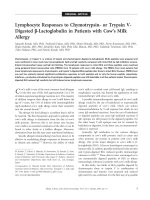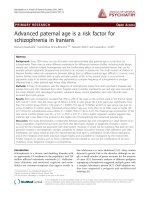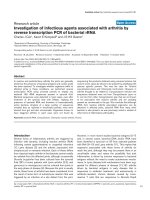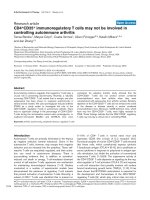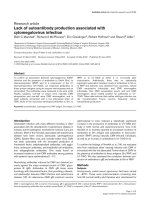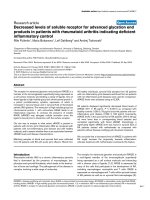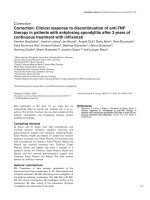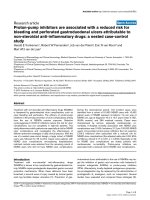Báo cáo y học: " Individual-level socioeconomic status is associated with worse asthma morbidity in patients with asthma" pps
Bạn đang xem bản rút gọn của tài liệu. Xem và tải ngay bản đầy đủ của tài liệu tại đây (564.42 KB, 8 trang )
BioMed Central
Page 1 of 8
(page number not for citation purposes)
Respiratory Research
Open Access
Research
Individual-level socioeconomic status is associated with worse
asthma morbidity in patients with asthma
Simon L Bacon
1,2,3
, Anne Bouchard
1,4
, Eric B Loucks
5
and Kim L Lavoie*
1,2,4
Address:
1
Montreal Behavioural Medicine Centre, Division of Chest Medicine, Research Center, Hôpital du Sacré-Cœur de Montréal - a University
of Montréal affiliated hospital, 5400 Gouin West, Montréal, Québec, H4J 1C5, Canada,
2
Department of Exercise Science, Concordia University,
7141 Sherbrooke St West, Montreal, Quebec, H4B 1R6, Canada,
3
Montreal Behavioural Medicine Centre, Research Center, Montreal Heart
Institute - a University of Montréal affiliated hospital, 5000 Belanger, Montreal, Quebec, H1T 1C8, Canada,
4
Department of Psychology, University
of Quebec at Montreal (UQAM), PO Box 8888, Succursale Center-Ville, Montreal, Quebec, H3C 3P8, Canada and
5
Department of Community
Health, Epidemiology Section, Center for Population Health & Clinical Epidemiology, Brown University, 121 South Main St, Providence, RI, USA
Email: Simon L Bacon - ; Anne Bouchard - ; Eric B Loucks - ;
Kim L Lavoie* -
* Corresponding author
Abstract
Background: Low socioeconomic status (SES) has been linked to higher morbidity in patients with
chronic diseases, but may be particularly relevant to asthma, as asthmatics of lower SES may have
higher exposures to indoor (e.g., cockroaches, tobacco smoke) and outdoor (e.g., urban pollution)
allergens, thus increasing risk for exacerbations.
Methods: This study assessed associations between adult SES (measured according to educational
level) and asthma morbidity, including asthma control; asthma-related emergency health service
use; asthma self-efficacy, and asthma-related quality of life, in a Canadian cohort of 781 adult
asthmatics. All patients underwent a sociodemographic and medical history interview and
pulmonary function testing on the day of their asthma clinic visit, and completed a battery of
questionnaires (Asthma Control Questionnaire, Asthma Quality of Life Questionnaire, and Asthma
Self-Efficacy Scale). General Linear Models assessed associations between SES and each morbidity
measure.
Results: Lower SES was associated with worse asthma control (F = 11.63, p < .001), greater
emergency health service use (F = 5.09, p = .024), and worse asthma self-efficacy (F = 12.04, p <
.01), independent of covariates. Logistic regression analyses revealed that patients with <12 years
of education were 55% more likely to report an asthma-related emergency health service visit in
the last year (OR = 1.55, 95%CI = 1.05-2.27). Lower SES was not related to worse asthma-related
quality of life.
Conclusions: Results suggest that lower SES (measured according to education level), is
associated with several indices of worse asthma morbidity, particularly worse asthma control, in
adult asthmatics independent of disease severity. Results are consistent with previous studies
linking lower SES to worse asthma in children, and add asthma to the list of chronic diseases
affected by individual-level SES.
Published: 17 December 2009
Respiratory Research 2009, 10:125 doi:10.1186/1465-9921-10-125
Received: 5 July 2009
Accepted: 17 December 2009
This article is available from: />© 2009 Bacon et al; licensee BioMed Central Ltd.
This is an Open Access article distributed under the terms of the Creative Commons Attribution License ( />),
which permits unrestricted use, distribution, and reproduction in any medium, provided the original work is properly cited.
Respiratory Research 2009, 10:125 />Page 2 of 8
(page number not for citation purposes)
Background
Asthma is a chronic disorder of the airways characterized
by reversible and intermittent airway obstruction, airway
inflammation, and hyper-reactivity of the airways in
response to a variety of stimuli (e.g., dust, animal hair,
smoke, and airborne pollutants). Despite important
advances in diagnosis and treatment, asthma remains one
of the most prevalent chronic respiratory disorders, affect-
ing 7-10% of the world's population. Rather than decreas-
ing, prevalence rates of asthma over the past three decades
are actually rising in all age, sex, and racial groups in
North America [1].
The global burden of asthma appears to be related to poor
asthma control, which is associated with more frequent
asthma symptomatology and bronchodilator use, worse
pulmonary function, greater emergency health service uti-
lization, and greater functional impairment (absenteeism,
participation in social activities) [2,3]. In Canada, asthma
remains poorly controlled in nearly 60% of patients,
which places an excess burden on the health care system,
and accounts for between 250-300 deaths per year [4,5].
Given that asthma can be well controlled for the vast
majority of patients [2,3], identifying those patients who
may be at greater risk for poorly controlled asthma repre-
sents an important goal for global asthma prevention.
Socioeconomic status (SES) has been linked to various
health outcomes, with lower SES being associated with
higher rates of morbidity and mortality from several
chronic diseases, including cardiovascular disease,
chronic obstructive pulmonary disease, and diabetes [6-
8]. However, SES may be particularly relevant to asthma
due to pathways by which it could adversely impact
asthma outcomes. At the individual level (e.g., education
attainment, income), asthmatics of lower SES may have
higher exposures to indoor (e.g., cockroaches, tobacco
smoke [9]) and outdoor (e.g., urban pollution [9]) aller-
gens, and tend to use less inhaled corticosteroids [10],
thus increasing risk for acute asthma exacerbations [9,11].
Though the SES-asthma link has been well established in
children [12,13] and to some degree using area-level
measures of SES (e.g., use of zipcodes or postal codes to
define deprivation) in adults [14,15], less is known about
associations between individual-level SES and asthma in
adults.
The purpose of the present study was to assess associa-
tions between adult individual-level SES, measured
according to education level, and several measures of
asthma morbidity and health, including levels of asthma
control, emergency health service use, asthma self-effi-
cacy, and asthma-related quality of life in a Canadian
cohort of asthmatics. It was hypothesized that SES would
be significantly and negatively associated with these meas-
ures of asthma morbidity and health.
Methods
Study participants
A total of 781 consecutive adults with physician-diag-
nosed asthma (confirmed by chart evidence of a 20% fall
in forced expiratory volume in 1 second (FEV
1
) after
methacholine challenge and/or bronchodilator reversibil-
ity in FEV
1
of ≥ 20% predicted [16]) were recruited from
the outpatient asthma clinic of Hôpital du Sacré-Coeur de
Montréal between June 2003-January 2007. Patients were
eligible for the study if they were between the ages of 18
and 75 years and could communicate fluently in either
French or English. Patients were excluded if they had
occupational asthma, a co-morbid medical condition that
significantly impacted health outcomes (e.g., cardiovascu-
lar disease, chronic obstructive pulmonary disease), evi-
dence of severe psychopathology (e.g., schizophrenia), or
cognitive deficits such that they could not give consent. A
total of 1904 patients presented to the asthma clinic, of
whom 1739 patients (91%) were screened for inclusion in
the study (the remaining 165 patients had insufficient
medical information with which to conduct pre-screen-
ing). A total of 885 patients were excluded (n = 358 due to
existence of comorbid disease that conferred greater risk
for morbidity than asthma, or the presence of severe psy-
chopathology or substance abuse, n = 273 due to uncon-
firmed asthma or occupational asthma; n = 204 due to age
criteria; and n = 50 due to language criteria), resulting in
854 eligible patients who were contacted to participate in
the study. Only 53 patients declined to participate, which
yielded a sample of 801 patients (94% participation rate).
Twenty patients were excluded from analyses due to
incomplete or missing data, yielding a final sample of 781
patients. This project was approved by the Ethics Commit-
tee of Hôpital du Sacré-Cœur de Montréal, and written
consent was obtained from all participants.
Study Design
This cross-sectional study was conducted as part of a larger
study evaluating the prevalence and impact of psychiatric
disorders among adult asthmatics [17]. Briefly, patients
were screened to determine eligibility on the day of their
regular asthma clinic. All patients underwent a sociode-
mographic interview (including questions about educa-
tional attainment), and a medical/asthma history
interview (including assessments of height and weight for
the calculation of body mass index, BMI) followed by a
brief psychiatric interview (Primary Care Evaluation for
Mental Disorders, PRIME-MD) that was administered by
a trained, clinical research assistant. SES was measured
according to educational level (total number of years
completed), which is one of the most common measures
Respiratory Research 2009, 10:125 />Page 3 of 8
(page number not for citation purposes)
of individual-level SES [18]. Educational attainment is fre-
quently used as a measure of SES, because it is stable over
time, unlike occupation and income that can fluctuate
over the life course. Furthermore, participant response
rates tend to be higher for educational attainment, unlike
income which typically has lower response rates and con-
sequently high response bias [18]. Asthma severity was
classified based on Global Initiative for Asthma (GINA)
guidelines [2] that classifies asthma severity into four cat-
egories (mild intermittent, mild persistent, moderate per-
sistent, and severe persistent). To calculate asthma
severity, all patients underwent standard spirometry to
assess pulmonary function (FEV
1
and forced vital capacity
(FVC)). Patients completed a battery of questionnaires
assessing asthma control (Asthma Control Questionnaire,
ACQ), self-efficacy (Asthma Self-Efficacy Scale, ASES),
and quality of life (Asthma Quality of Life Questionnaire,
AQLQ). All self-reported clinical data, including medical/
asthma history, asthma related hospital events, atopy sta-
tus (based on skin prick testing [19]) and medication dos-
age, were verified by a clinical research assistant
consulting the patient's medical chart.
Questionnaire and Psychological Measures
Asthma Control Questionnaire (ACQ)
The ACQ [20] is a 7-item self-report questionnaire that
assesses levels of asthma control in the last week accord-
ing to standard criteria specified by international guide-
lines [2]. Items are rated on a 7-point scale, where 0
indicates good control and 6 indicates poor control, to
yield a mean score out of 6. Patients are asked to report
their symptoms, limitations in their daily activities, and
bronchodilator use in the last week. FEV
1
% predicted)
was calculated from the pulmonary function test. The
ACQ has demonstrated excellent measurement proper-
ties, has been validated in Canadian French, and scores of
≥ 0.8 indicate poorly controlled asthma [21]. For the cur-
rent study, the internal consistency of the questionnaire
was high (Cronbach's α = .84).
Asthma Self-Efficacy Scale (ASES)
The ASES [22] is an 80-item self-report questionnaire that
assesses asthmatics' beliefs or confidence in their ability to
successfully control or avoid an asthma attack in a variety
of situations. The ASES is rated on a 5-point scale where 0
indicates "no confidence" and 4 indicates "very confi-
dent", to yield a final score out of 320 (with higher scores
indicating better asthma self-efficacy). The ASES has
shown to be a reliable and valid measure of asthma-spe-
cific self-efficacy and has been used extensively in previ-
ous studies [22,23]. For the current study, the internal
consistency of the questionnaire was high (Cronbach's α
= .98).
Asthma Quality of Life Questionnaire (AQLQ)
The AQLQ is a 32-item self-report questionnaire that
assesses asthma-related quality of life across four life
domains that may affected by asthma: symptoms, activity
limitations, environmental stimuli, and emotional dis-
tress [24]. Items are rated on a 7-point scale, where 1 indi-
cates very poor asthma-related quality of life and 7
indicates very good asthma-related quality of life, to yield
a mean score out of 7. The AQLQ has demonstrated excel-
lent measurement properties and has been validated in
Canadian French [25]. For the current study, the internal
consistency of the questionnaire was high (Cronbach's α
= .96).
Primary Care Evaluation of Mental Disorders (PRIME-MD)
The PRIME-MD [26] assesses the prevalence (i.e., present
or not) of mood (major and minor depression, dys-
thymia) and anxiety (panic disorders, generalized anxiety
disorder, other anxiety disorder) using algorithms that are
based on DSM-IV. It has been shown to be of comparable
sensitivity, specificity and reliability as longer structured
interviews, and takes approximately 10 to 20 minutes to
administer and score [26].
Analyses
Though main analyses were conducted using both contin-
uous and dichotomous measures of education, sociode-
mographic, and medical/asthma history characteristics
were presented as a function of low (<12 years of educa-
tion) versus high (≥ 12 years of education) SES, i.e., the
dichotomous measure. These cutoffs were chosen to
reflect those who had (≥ 12) and had not (<12) com-
pleted high school. To assess the strength and direction of
the association between SES as a continuous variable (i.e.,
years of education) and asthma morbidity measures
(ACQ, ASES and AQLQ scores) a series of general linear
models (GLM's) were conducted adjusting for age, sex,
and asthma severity. In order to examine the robustness of
our findings, an additional series of GLM's were con-
ducted additionally adjusting for comorbid medical char-
acteristics (current smoking, BMI, and having a mood
and/or anxiety disorder [binary yes-no response]) that
have been associated with worse asthma outcomes
[17,27,28]. All covariates were determined a-priori. Two
Poisson regression models was conducted to assess the
relationship between years of education and emergency
health service use [total number of emergency department
visits and hospitalizations for asthma] in the past year,
using the same covariates specified above. Theses models
used a repeated statement in order to obtain robust stand-
ard errors for the Poisson regression coefficients. Finally,
two logistic regressions were conducted to assess the
impact of SES on the risk of emergency health service use
in the last year (defined as a binary variable), using the
Respiratory Research 2009, 10:125 />Page 4 of 8
(page number not for citation purposes)
same covariates specified above. All tests were two-sided
and significance level was set at p < .05. Data analysis was
performed using SAS v.9.1 (SAS Institute, Cary NC).
Results
Sample characteristics
The final sample of 781 patients included 467 (60%)
women with a mean (SD) age of 48.5 (14.3) years. The
mean (SD) duration of asthma for sample was 18.6 (15.2)
years and 71% (n = 555) were atopic. The mean (SD) edu-
cational level was 12.9 (3.6) years (range 2-23 years) of
schooling. Mean sample (SD) [range] for ACQ, ASES and
AQLQ scores were 1.6 (1.1) [0.0-6.0], 222.3 (66.1) [13.3-
320], and 5.1 (1.2) [1.5-7.0] respectively. A total of 184
(24%) of the sample reported a mean (SD) [range] of 2.1
(2.0) [1-15] emergency health service visits in the last
year. Mean (SD) pulmonary function (% FEV1, %FVC,
FEV1/FVC) for the sample was 78.9 (21.8), 89.5 (19.6),
and 72.4 (14.4) respectively.
Demographic and medical/asthma history characteristics
Demographic and medical/asthma history characteristics
as a function of low (<12 years education) versus high (≥
12 years education) SES are presented in table 1. Relative
to patients with a higher SES, those with a lower SES were
older and more likely to be unemployed. In addition,
patients with a lower SES were more likely to engage in
poor health behaviors, including being more likely to be
current smokers, having a higher number of pack-years,
and having a higher BMI.
With regards to asthma, patients with a lower SES were
less likely to be diagnosed with atopy but were more likely
to have moderate or severe (relative to intermittent or
mild) asthma, and took their bronchodilator significantly
more often than higher SES patients.
Association between SES, asthma morbidity and health
Associations between SES and asthma morbidity variables
are presented in Table 2. GLM analyses revealed that that
lower SES was negatively associated with higher ACQ
scores (i.e., worse asthma control) and lower ASES scores,
independent of age, sex, and asthma severity. When addi-
tional covariates (current smoking, BMI, and having a
mood and/or anxiety disorder) were added to the model,
lower SES remained significantly associated with higher
ACQ scores and lower ASES scores. In addition, there was
an approximate 30% reduction in the β after adjusting for
covariates, suggesting these variables accounted for some
but not all of the association strength There were no asso-
ciations between SES and AQLQ scores. Poisson regres-
sion revealed that lower SES was associated with greater
emergency health service use, independent of age, sex,
asthma severity (estimate = -0.07, SE = 0.02, 95%CI = -
Table 1: Demographic and medical/asthma characteristics presented as a function of high versus low SES
Low (< 12 yrs education)
n = 306
High (≥ 12 yrs education)
n = 475
Mean or % 95% CI Mean or % 95% CI F p
Demographics
Age (yrs)* 52.3 50.8, 53.9 46.0 44.8, 47.3 37.42 < .001
Sex (% Male) 40 35, 46 40 36, 45 0.00 .997
Ethnicity (% Caucasian) 91 88, 94 92 90, 95 0.44 .518
Cohabitating (% yes) 68 62, 73 65 61, 70 0.47 .492
Employed (% yes) 49 43, 54 72 68, 76 45.73 < .001
Medical characteristics
BMI (kg/m
2
)* 27.8 27.3, 28.4 26.6 26.1, 27.0 12.32 < .001
Current smoker (% yes) 13 9, 16 8 5, 10 5.75 .017
Pack-years†* 12.9 10.9, 14.9 6.6 5.0, 8.1 23.84 < .001
Psychiatric comorbidity (% yes)¶ 32 27, 37 27 23, 32 2.02 .156
Asthma characteristics
FEV1 (% predicted)* 77.3 74.6, 79.9 79.9 77.8, 82.0 2.32 .129
FVC (% predicted)* 87.8 85.3, 90.2 90.5 88.6, 92.4 3.03 .082
FEV1/FVC* 71.4 69.6, 73.2 72.9 71.6, 74.3 1.78 .183
Asthma severity (% moderate or severe) 92 88, 96 84 80, 87 10.94 .001
Asthma duration (yrs)* 18.2 16.5, 19.9 18.9 17.5, 20.3 0.45 .502
Atopic (% yes) 62 57, 67 77 73, 81 23.01 < .001
Bronchodilator use (# times in last week)* 9.6 7.9, 11.3 7.0 5.6, 8.3 5.77 .017
FEV1 = forced expiratory volume in 1 second; FVC = forced vital capacity; BMI = body mass index;
* These values are reported as means
† pack-years = average number of packs (20 cigarettes/pack) smoked per day X number of years smoked;
¶ Mood and-or anxiety disorder
Respiratory Research 2009, 10:125 />Page 5 of 8
(page number not for citation purposes)
0.10- -0.03), and all additional covariates (estimate = -
0.05, SE = 0.02, 95%CI = -0.09- -0.01), with a minimal
change in the estimate. Logistic regression analyses
revealed that patients with < 12 years of education were
55% more likely to report being hospitalized or having an
emergency department visit in the last year (OR = 1.55,
95%CI = 1.05-2.27), independent of age, sex, and asthma
severity. When factors expected to mediate the association
between education and asthma severity (i.e. current smok-
ing, BMI, and having a mood and/or anxiety disorder)
were added to the model, the magnitude of the effect was
slightly reduced and became no longer statistically signif-
icant (OR = 1.46, 95%CI = 0.98-2.17).
Discussion
The present study assessed associations between individ-
ual-level SES (measured according to educational attain-
ment) and multiple measures of asthma morbidity in a
Canadian cohort of adult asthmatics. Results showed that
patients with lower SES had worse asthma control, worse
asthma self-efficacy, and greater emergency health service
use relative to patients with higher SES, independent of
age, sex, asthma severity, current smoking, BMI, and hav-
ing a mood and/or anxiety disorder. We also found that
patients with less than 12 years of education were 55%
more likely to report any emergency health service use,
compared to those with 12 or greater years of education,
when controlling for age, sex, and severity. When the
additional covariates were included in the model, this
relationship was no longer statistically significant. How-
ever, though statistical significance was lost, there was a
minimal change in the point estimate, suggesting that
mediation was unlikely. Furthermore, the Poisson regres-
sion models indicated that the relationship between edu-
cation and emergency healthcare usage may be graded
and have a dose-response association, even with the inclu-
sion of all covariates.
These findings are consistent with previous studies find-
ing significant associations between lower childhood SES
and worse asthma morbidity, including increased preva-
lence of asthma and severe asthma [12,13], and increased
risk of emergency department visits and hospitalizations
for asthma [29,30]. These findings are also in line with
previous studies linking lower SES (assessed using area-
level and individual-level measures) to worse asthma
morbidity in adults, including increased prevalence of
asthma [31], greater asthma symptomatology [32], and
increased asthma related hospitalisations [33]. However,
this study is, to our knowledge, the first to assess the
impact of individual-level SES on multiple measures of
asthma morbidity in such a large Canadian cohort of
adult asthmatics. Although Lynd et al. [34] examined the
link between both individual and area-level measures of
SES and asthma in a Canadian sample, their sample size
was modest (n = 202), and their analyses focused on links
between SES and short-acting bronchodilator use as a
proxy measure of asthma control. Their findings are still
consistent with those of our study, though we were able to
extend their findings by showing that asthmatics of lower
SES have worse asthma control according to the ACQ and
emergency health service use.
It is noteworthy that patients with lower SES were more
likely to exhibit poor health behaviors that may exacer-
bate asthma, including higher rates of current smoking,
total pack-years, and BMI. This is consistent with previous
studies linking higher rates of smoking, obesity, reduced
consumption of fruits and vegetables, and higher con-
sumption of saturated fats in low SES individuals com-
pared to high SES individuals [35-37]. The higher
prevalence of poor health behaviors among socially disad-
vantaged adults with asthma may partially explain why
these patients were more poorly controlled. However, the
fact we found lower SES to be related to worse asthma
control after adjustment for BMI and smoking suggests
these were not the only potential mechanisms linking
lower SES to poor control in this study. For example, and
as detailed above, nutrition may also play a role. It must
also be noted that our assessments of smoking and BMI
may be imperfect (e.g., central adiposity may be more
important than total body composition). Though the cur-
rent study was not designed to assess the potential mech-
anisms linking lower SES to increased asthma morbidity,
Table 2: Association between educational attainment and asthma morbidity variables (GLM)
model adjustment
age, sex, asthma severity age, sex, asthma severity, BMI, smoking, and psychiatric disorder
β (SE) F p β (SE) F p
ACQ -0.041 (0.011) 14.12 < .001 -0.027 (0.011) 5.82 .016
ASES 2.797 (0.787) 12.65 < .001 2.110 (0.795) 7.04 .008
AQLQ 0.021 (0.014) 2.34 .127 0.004 (0.014) 0.08 .783
ACQ = Asthma Control Questionnaire; ASES = Asthma Self-Efficacy Scale; AQLQ = Asthma Quality of Life Questionnaire.
Respiratory Research 2009, 10:125 />Page 6 of 8
(page number not for citation purposes)
they can be found in previous studies. For example, lower
SES was associated with lower use of inhaled corticoster-
oids [10] and lower corticosteroid adherence [38], though
not all studies have reported this [39]. The current study
did not collect data on medication adherence, but the
results were independent of asthma severity, which is pri-
marily derived from the prescribed dosage of inhaled cor-
ticosteroids. Furthermore, a previous study has shown
that SES was related to ACQ scores independent of corti-
costeroid use [40]. There is also evidence that the underly-
ing physiological processes seen in asthma are influenced
by SES, where heightened inflammatory responses to sim-
ilar doses of antigen challenge have been shown in
patients with low versus high SES [41,42], which may be
a consequence of low SES individuals overexpressing
genes regulating their inflammatory processes [43]. How-
ever, it should be noted that these findings are drawn
from data in children and needs to be replicated in adult
samples.
One additional finding that warrants discussion is that
asthmatics of lower SES were less likely to be atopic (i.e.,
have allergic asthma) than asthmatics of higher SES.
Although this was not the primary aim of the analyses,
this finding is consistent with several studies linking lower
SES to lower incidence of allergic asthma [31,32,44,45].
Although controversial, it has been suggested that this
relationship may be due to the "hygiene hypothesis,"
which proposes that the development of atopic asthma
and allergy may be prevented via prenatal and-or early
childhood exposure to immune system stimulants (e.g.,
bacteria, viruses and endotoxins) that shift T-helper type 2
cell (Th2) dominance to T-helper type 1 cell (Th1) domi-
nance [46,47]. This shift in cytokine balance is thought to
contribute to allergic asthma and allergy, and may be
induced by a lack of early exposures to microbial environ-
ments [46], which are typical in lower SES settings (e.g.,
poor housing conditions that may be overcrowded,
infested with cockroaches and dust mites, and poorly
insulated, leading to greater exposure to infections, aller-
gens, and mould). Our finding of less atopic asthma in
patients of lower SES may therefore lend support for the
"hygiene hypothesis." However, given the fact that this is
a secondary finding, and the controversies surrounding
the "hygiene hypothesis," further investigation is clearly
needed.
Surprisingly, we did not observe any significant associa-
tion between SES and asthma-related quality of life, which
was contrary to our expectations and to previous findings
[14,48]. Both lower area-level SES [14] and composite
individual-level SES [48] have been associated with worse
general and asthma-specific quality of life. The reasons for
these inconsistencies are not clear. However, they may be
related to issues associated with the nature of the popula-
tions assessed and to study design. For example, Blanc et
al. [14] recruited patients from multiple clinics via physi-
cian referral, as well as using random-digit telephone
recruitment; whereas we recruited consecutive patients
from a single tertiary-care clinic where asthma is generally
more severe and thus may reduce variability in quality of
life measures. The Apter et al. [48] study found that the
relationship between SES and quality of life was highly
confounded by race/ethnicity, with non-Caucasians hav-
ing lower SES and poorer quality of life. While the Apter
et al. study consisted of nearly 60% of non-Caucasians,
the current study has less than 10% non-Caucasions, sug-
gesting that the results reported by Apter et al. may have
been driven by race/ethnicity rather than SES [49]. In
addition, the significant association between SES and
worse asthma-specific quality of life in Blanc et al.'s study
was observed using a different measure of SES (i.e., area-
level), and a different quality of life scale (i.e., Marks
Asthma Quality of Life Questionnaire) than those used in
the present study. As such, the disparate findings between
these two studies may be attributable to the specific choice
of measures. Further replication studies are needed to
shed more light on the association between SES and
asthma-related quality of life in adult samples.
The results of this study need be interpreted in considera-
tion of some methodological limitations. First, patients
were recruited from the asthma clinic of a single tertiary-
care urban hospital, so results may not generalize to rural
centers or community samples. Second, we relied upon
education level as our measure of individual-level SES,
when it may have been more informative to use a com-
posite measure (e.g., education level, income, and-or
occupation), or to triangulate analyses using occupation
and income as separate measures of SES. Unfortunately,
the only additional variable we collected was on employ-
ment status (yes-no). In addition, it should be noted that
that education is the most common measure of individ-
ual-level SES and is stable over time, unlike occupation
and income, that can fluctuate over the life course. Fur-
thermore, participant response rates tend to be higher for
educational attainment, unlike income which typically
has lower response rates and consequently high response
bias [18]. Third, the study was cross-sectional so reverse
causality may be possible, though unlikely, and education
and asthma morbidity may be linked in a non-causal fash-
ion. As such, further longitudinal studies are needed to
confirm the temporal sequence of the results in the cur-
rent study. Finally, our study was limited by the fact that
we were not able to assess other environmental variables
that are associated with SES that may have partially
accounted for our findings such as actual exposure levels
to allergens, irritants, and pollutants, and living condi-
tions (i.e., overcrowding) which may have increased the
risk of respiratory infections that confer risk for worse
Respiratory Research 2009, 10:125 />Page 7 of 8
(page number not for citation purposes)
asthma morbidity [32]. Despite these limitations, the
results of the present study complement and strengthen
previous reports by including a large cohort of adult asth-
matics with objectively confirmed physician-diagnosed
asthma and atopy, and the measurement of a range of
asthma morbidity and health measures that included self-
reported symptoms and objectively measured emergency
health service utilization that was verified by chart review.
Due to the range and depth of our assessments, we were
also able to control for a number of potential confound-
ers, including smoking status, BMI, psychiatric comorbid-
ity, and asthma severity, which attests to the robustness of
the findings.
Conclusions
In summary, this study found evidence for an association
between education level (which is indicative of SES) and
asthma morbidity and health in a large tertiary-care sam-
ple of Canadian adults with asthma, with lower education
levels being related to worse levels of asthma control and
asthma self-efficacy, and higher rates of emergency health
care use for asthma in the past year. As this study was not
designed to examine the mechanisms linking SES to
asthma morbidity, future studies should examine the
pathways by which SES influences asthma morbidity
among adults and the extent to which they may differ
from the pathways proposed in children. In addition,
while directly intervening on SES is difficult, once the
mechanisms of the SES-asthma relationship have been
identified interventions need to be developed to improve
asthma outcomes in low SES patients [50].
Competing interests
The authors declare that they have no competing interests.
Authors' contributions
SLB co-wrote the manuscript, conducted all statistical data
analyses, and obtained funding for the study. AB collected
primary data and helped develop the conceptual idea. EBL
helped develop the conceptual framework and provided
critical feedback on manuscript drafts. KLL conceived of
the study, participated in its design and coordination,
obtained funding for the study, and co-wrote the manu-
script. All authors read and approved the final manu-
script.
Acknowledgements
The authors thank Guillaume Lacoste, BA, for his invaluable assistance with
data collection. Funding support for this study was provided by salary
awards from the Fonds de la recherche en santé du Québec (FRSQ) (SLB
& KLL) and the Canadian Institutes of Health New Investigator Award
(CIHR) (SLB & EBL), grant support from the FRSQ (SLB & KLL) and the
Michel Auger Foundation of Hôpital du Sacré-Coeur de Montréal (KLL),
and scholarship support from FRSQ and the Social Science and Humanities
Research Council (SSHRC) (AB).
References
1. Asthma prevalence, health care use and mortality: United
States, 2003-05 [ />05/asthma03-05.htm]
2. GINA Dissemination Committee: Dissemination and Implementation of
Asthma Guidelines Global Initiative For Asthma; 2003.
3. Bateman ED, Boushey HA, Bousquet J, Busse WW, Clark TJH, Pau-
wels RA, Pedersen SE, for the GOAL Investigators Group: Can
Guideline-defined Asthma Control Be Achieved?: The Gain-
ing Optimal Asthma ControL Study. Am J Respir Crit Care Med
2004, 170:836-844.
4. Table 102-0552 - Deaths, by selected grouped causes and
sex, Canada, provinces and territories, annual, CANSIM
(database) [ />cgi.exe?Lang=E&CNSM-Fi=CII/CII_1-eng.htm]
5. Aboussafy D, Balter M, Godin G, Lavoie KL, Koley S: Asthma: The Psy-
chology of Compromise Ottawa: Canadian Lung Association; 2004.
6. Cooper R, Cutler J, Desvigne-Nickens P, Fortmann SP, Friedman L,
Havlik R, Hogelin G, Marler J, McGovern P, Morosco G, Mosca L,
Pearson T, Stamler J, Stryer D, Thom T: Trends and Disparities in
Coronary Heart Disease, Stroke, and Other Cardiovascular
Diseases in the United States: Findings of the National Con-
ference on Cardiovascular Disease Prevention. Circulation
2000, 102:3137-3147.
7. O'Malley AS, Pham HH, Schrag D, Wu B, Bach PB: Potentially
avoidable hospitalizations for COPD and pneumonia: the
role of physician and practice characteristics. Med Care 2007,
45:562-570.
8. Brown AF, Ettner SL, Piette J, Weinberger M, Gregg E, Shapiro MF,
Karter AJ, Safford M, Waitzfelder B, Prata PA, Beckles GL: Socioe-
conomic Position and Health among Persons with Diabetes
Mellitus: A Conceptual Framework and Review of the Liter-
ature. Epidemiol Rev 2004, 26:63-77.
9. Wright RJ, Fisher EB: Putting asthma into context: community
influences on risk behaviour, and intervention. In Neighbor-
hoods and health Edited by: Kawachi I, Berkman LF. Oxford, United
Kingdom: Oxford University Press; 2003:233-264.
10. Barr RG, Somers SC, Speizer FE, Camargo CA Jr, National Asthma
Education Prevention Program: Patient factors and medication
guideline adherence among older women with asthma. Arch
Int Med 2002, 162:1761-1768.
11. Laurent O, Filleul L, Havard S, Deguen S, Declercq C, Bard D:
Asthma attacks and deprivation: gradients in use of mobile
emergency medical services. Journal of Epidemiology and Commu-
nity Health 2008, 62:1014-1016.
12. Mielck A, Reitmeir P, Wjst M: Severity of Childhood Asthma by
Socioeconomic Status. Int J Epidemiol 1996, 25:388-393.
13. Almqvist C, Pershagen G, Wickman M: Low socioeconomic status
as a risk factor for asthma, rhinitis and sensitization at 4
years in a birth cohort. Clin Exp Allergy 2005, 35:612-618.
14. Blanc PD, Yen IH, Chen H, Katz PP, Earnest G, Balmes JR, Trupin L,
Friedling N, Yelin EH, Eisner MD: Area-level socio-economic sta-
tus and health status among adults with asthma and rhinitis.
Eur Resp J 2006, 27:
85-94.
15. Boudreaux ED, Emond SD, Clark S, Camargo CA Jr: Acute Asthma
Among Adults Presenting to the Emergency Department:
The Role of Race/Ethnicity and Socioeconomic Status. Chest
2003, 124:803-812.
16. American Thoracic Society: Standardization of Spirometry,
1994 Update. Am J Respir Crit Care Med 1995, 152:1107-1136.
17. Lavoie KL, Cartier A, Labrecque M, Bacon SL, Lemiere C, Malo J-L,
Lacoste G, Barone S, Verrier P, Ditto B: Are psychiatric disorders
associated with worse asthma control and quality of life in
asthma patients? Resp Med 2005, 99:1249-1257.
18. Krieger N, Williams DR, Moss NE: Measuring social class in the
US public health resaerch: Concepts, methodologies, and
guidelines. Annu Rev Public Health 1997, 18:341-378.
19. Barone S, Bacon S, Campbell T, Labrecque M, Ditto B, Lavoie K: The
association between anxiety sensitivity and atopy in adult
asthmatics. J Behav Med 2008, 31:331-339.
20. Juniper EF, O'Byrne PM, Guyatt GH, Ferrie PJ, King DR: Develop-
ment and validation of a questionnaire to measure asthma
control. Eur Resp J 1999, 14:902-907.
21. Asthma Control Questinnnaire (ACQ) [http://
www.qoltech.co.uk/acq.html]
Publish with BioMed Central and every
scientist can read your work free of charge
"BioMed Central will be the most significant development for
disseminating the results of biomedical research in our lifetime."
Sir Paul Nurse, Cancer Research UK
Your research papers will be:
available free of charge to the entire biomedical community
peer reviewed and published immediately upon acceptance
cited in PubMed and archived on PubMed Central
yours — you keep the copyright
Submit your manuscript here:
/>BioMedcentral
Respiratory Research 2009, 10:125 />Page 8 of 8
(page number not for citation purposes)
22. Tobin DL, Wigal JK, Winder JA, Holroyd KA, Creer TL: The
"Asthma Self-Efficacy Scale". Ann Allergy 1987, 59:273-277.
23. Lavoie KL, Bouchard A, Joseph M, Campbell TS, Favreau H, Bacon SL:
Association of Asthma Self-efficacy to Asthma Control and
Quality of Life. Ann Behav Med 2008, 36:100-106.
24. Juniper EF, Guyatt GH, Ferrie PJ, Griffith LE: Measuring quality of
life in asthma. Am Rev Resp Dis 1993, 147:832-838.
25. Asthma Quality of Life Questionnaire (AQLQ) [http://
www.qoltech.co.uk/aqlq.html]
26. Spitzer RL, Williams JB, Kroenke K, Linzer M, deGruy FV, Hahn SR,
Brody D, Johnson JG: Utility of a new procedure for diagnosing
mental disorders in primary care. The PRIME-MD 1000
study. JAMA 1994, 272:1749-1756.
27. Lavoie KL, Bacon SL, Labrecque M, Cartier A, Ditto B: Body mass
index is associated with worse asthma control and quality of
life among adult asthma patients. Resp Med 2006, 100:648-657.
28. Piipari R, Jaakkola JJK, Jaakkola N, Jaakkola MS: Smoking and
asthma in adults. Eur Resp J 2004, 24:734-739.
29. Maziak W, von Mutius E, Keil U, Hirsch T, Leupold W, Rzehak P, Beh-
rens T, Weiland SK: Predictors of health care utilization of chil-
dren with asthma in the community. Pediatr Allergy Immunol
2004, 15:166-171.
30. Cesaroni G, Farchi S, Davoli M, Forastiere F, Perucci CA: Individual
and area-based indicators of socioeconomic status and child-
hood asthma. Eur Resp J 2003, 22:619-624.
31. Braback L, Hjern A, Rasmussen F: Social class in asthma and
allergic rhinitis: a national cohort study over three decades.
Eur Resp J 2005, 26:1064-1068.
32. Corvalan C, Amigo H, Bustos P, Rona RJ: Socioeconomic Risk Fac-
tors for Asthma in Chilean Young Adults. Am J Pub Health 2005,
95:1375-1381.
33. Li X, Sundquist J, Sundquist K: Socioeconomic and occupational
groups and risk of asthma in Sweden. Occup Med (Oxf) 2008,
58:161-168.
34. Lynd LD, Sandford AJ, Kelly EM, Pare PD, Bai TR, FitzGerald JM, Anis
AH: Reconcilable Differences: A Cross-sectional Study of the
Relationship Between Socioeconomic Status and the Magni-
tude of Short-Acting {beta}-Agonist Use in Asthma. Chest
2004, 126:1161-1168.
35. Hanson MD, Chen E: Socioeconomic status and health behav-
iors in adolescence: a review of the literature. J Behav Med
2007, 30:263-285.
36. Klinnert MD, Nelson HS, Price MR, Adinoff AD, Leung DYM, Mrazek
DA: Onset and Persistence of Childhood Asthma: Predictors
From Infancy. Pediatrics 2001, 108:e69.
37. Hulshof KF, Brussaard JH, Kruizinga AG, Telman J, Löwik MR: Socio-
economic status, dietary intake and 10 y trends: the Dutch
National Food Consumption Survey. Eur J Clin Nutr 2003,
57:128-137.
38. Apter AJ, Reisine ST, Affleck G, Barrows E, ZuWallack RL: Adher-
ence with twice-daily dosing of inhaled steroids. Socioeco-
nomic and health-belief differences. Am J Respir Crit Care Med
1998, 157:1810-1817.
39. Janson C, Chinn S, Jarvis D, Burney P: Individual use of antiasth-
matic drugs in the European Community Respiratory Health
Survey. Eur Resp J 1998, 12:557-563.
40. de Vries MP, Bemt L van den, Lince S, Muris JWM, Thoonen BPA, van
Schayck CP: Factors associated with asthma control. Journal of
Asthma 2005, 42:659-665.
41. Chen E, Hanson MD, Paterson LQ, Griffin MJ, Walker HA, Miller GE:
Socioeconomic status and inflammatory processes in child-
hood asthma: the role of psychological stress. Journal of Allergy
& Clinical Immunology 2006, 117:1014-1020.
42. Chen E, Fisher EB, Bacharier LB, Strunk RC: Socioeconomic sta-
tus, stress, and immune markers in adolescents with asthma.
Psychosom Med 2003, 65:984-992.
43. Chen E, Miller GE, Walker HA, Arevalo JM, Sung CY, Cole SW:
Genome-wide transcriptional profiling linked to social class
in asthma. Thorax 2009, 64:38-43.
44. Ellison-Loschmann L, Sunyer J, Plana E, Pearce N, Zock JP, Jarvis D,
Janson C, Antó JM, Kogevinas M, European Community Respiratory
Health Survey: Socioeconomic status, asthma and chronic
bronchitis in a large community-based study. Eur Resp J 2007,
29:897-905.
45. Chen JT, Krieger N, Eeden SK Van Den, Quesenberry CP: Different
slopes for different folks: socioeconomic and racial/ethnic
disparities in asthma and hay fever among 173,859 U.S. men
and women. Environ Health Perspect 2002, 110:211-216.
46. Beisswenger C, Bals R: Interaction of allergic airway inflamma-
tion and innate immunity: hygiene and beyond.
J Occup Med
Toxicol 2008, 3(Suppl 1):S3.
47. Liu AH: Hygiene theory and allergy and asthma prevention.
Paediatr Perinatal Epidemiol 2007, 21(Suppl 3):2-7.
48. Apter AJ, Reisine ST, Affleck G, Barrows E, ZuWallack RL: The influ-
ence of demographic and socioeconomic factors on health-
related quality of life in asthma. Journal of Allergy & Clinical Immu-
nology 1999, 103:72-78.
49. Forno E, Celedon JC: Asthma and ethnic minorities: socioeco-
nomic status and beyond. Curr Opin Allergy Clin Immunol 2009,
9:154-160.
50. Bryant-Stephens T: Asthma disparities in urban environments.
Journal of Allergy & Clinical Immunology 2009, 123:1199-1206.
